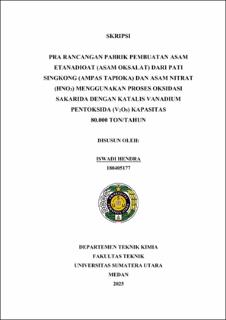| dc.description.abstract | Oxalic acid is highly useful and in great demand in various chemical industries due to its applications as a metal treatment, oxalate coating, textile cleaner, dyeing agent, wool dyeing, and so on. Oxalic acid can be produced from tapioca pulp, which contains a high starch content, through a process of hydrolysis and carbohydrate oxidation. The main objective of this preliminary design is to assess the feasibility of establishing a factory. Preliminary Design of a Plant for the Production of Ethanedioic Acid (Oxalic Acid) from Cassava Starch (Tapioca Waste) and Nitric Acid (HNO3) Using the Oxidation of Saccharides with Vanadium Pentoxide (V2O5) Catalyst, with a capacity of 80,000 tons/year and operating for 330 days per year. The main process in this preliminary design consists of four stages: hydrolysis, glucose purification, carbohydrate oxidation, and oxalic acid purification. This oxalic acid plant from tapioca waste is planned to be established in Central Lampung Province, Lampung, with a building area of 13,060 m3, requiring 171 workers, and will be operated as a Limited Liability Company (PT) led by one director with a line-and-staff organizational structure. The establishment and operation of the factory requires an investment capital of Rp. 1,114,951,198,528.760 and production costs of Rp. 549,060,112,604.015. Based on the feasibility analysis, this factory has a break-even point (BEP) of 40.07%, a return on investment (ROI) of 17.43%, a payback period (POT) of 5 years and 9 months, a net present value (NPV) of 29.05%, and an internal rate of return (IRR) of 26%. Based on the economic analysis, it can be concluded that the preliminary design of the factory for the production of ethanoic acid (oxalic acid) from cassava starch (tapioca residue) and nitric acid (HNO₃) using the saccharide oxidation process with vanadium pentoxide (V₂O₅) as a catalyst is feasible to establish. | en_US |


